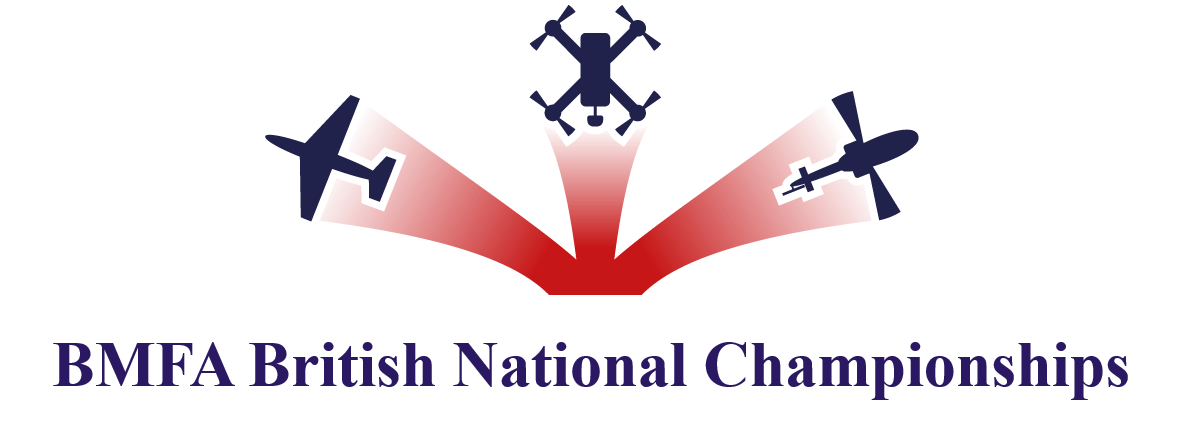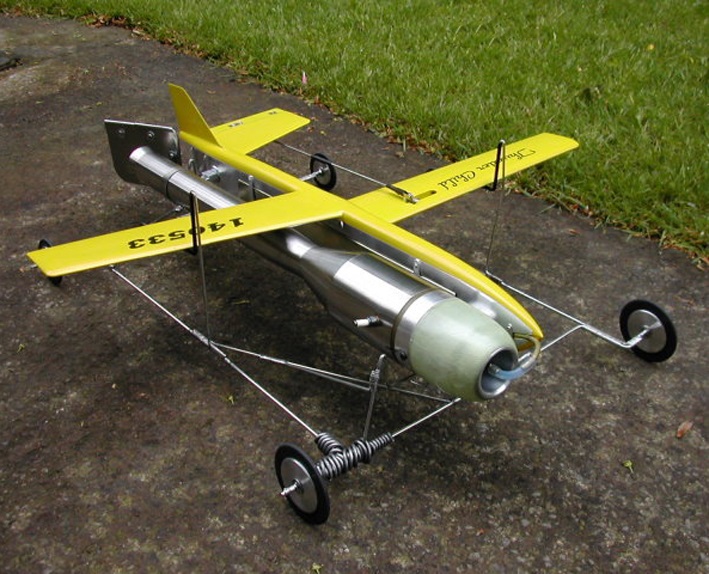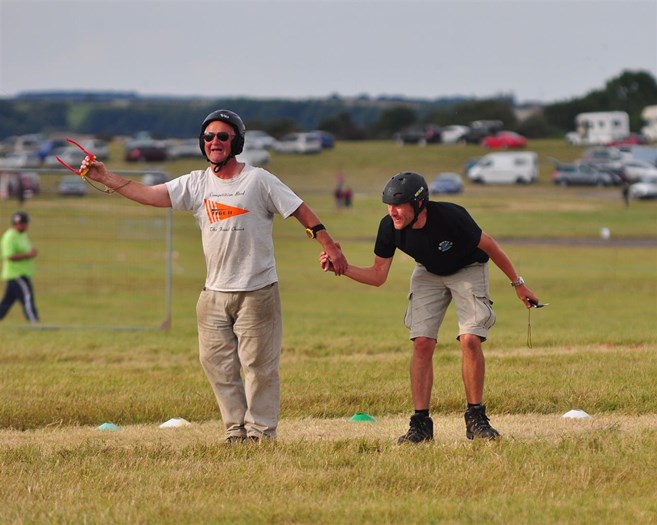Control line is a simple and light way of controlling a flying model aircraft. The aircraft is connected to the operator by a pair of lines, attached to a handle, that work the elevator of the model. There is also a control system that uses only a single solid wire that is twisted around its own axis, to apply torque to a control unit which moves the elevator. A third line is sometimes used to control the engine throttle, and more lines may be added to control other functions. Almost all control-line models are powered with conventional model aircraft engines of various types.
History
Models on lines and flying in circles predate manned flight. Early versions merely constrained the model to fly in a circle but offered no control. This is known as Round-the-pole flying. The origins of control-line flight are obscure but the first person to use a recognizably modern system is generally considered to be Oba St. Clair, in June 1936, near Gresham, Oregon. But the name most associated with the promotion of control line, and the inventor of the formerly patented system known as “U-Control” (which was a trademark, and is the system in use on virtually every two line control line model today) was Nevilles E. “Jim” Walker. His “American Junior” company was by far the biggest producer of models and held numerous patents on the two-line system.
The Airframe
Control-line model construction varies with the category of model. Aerobatics and combat models are relatively lightly built compared to R/C models as they need high manoeuvrability in the limited space offered by the control line “hemisphere”. They are typically built with traditional materials, but modern composite and graphite/epoxy are occasionally used in high-load applications. Combat models must also be relatively easy and quick to build as mid-air collisions and crashes are very common. Aerobatic model construction is typically quite complex and may require many hundreds of hours. Speed models must be very sturdy to withstand the forces of line tension and to permit a very rigid engine mount for maximum engine performance. Racing models need to be both relatively light and very strong to withstand the catch at pit-stops. In general, there are two types of fuselage construction that are used in control line – “profile” (flat) and “built up”. These are built with differing types of wings depending on the specific use of the aircraft. Profile models, where the fuselage is cut out from a single relatively thin sheet of wood with the “profile” of the aeroplane, are simple to build and repair, and are very common on trainer models. Built-up fuselages are much more difficult to build but generally look better and offer superior engine runs.
Controls
To control the aeroplane, the lines must remain in tension. Centrifugal force is generally sufficient to maintain line tension. The aircraft is typically controlled by a set of 20-70 foot lines. For competition the lines are tested before every flight with a “pull test” that varies with the model weight and category to verify that the lines and control system (primarily the bellcrank and its attachment) will withstand the line tension during flight.
The controls of a conventional 2-line/”U-Control” system consist of lead-out cables, a bell-crank, push rods and control horns. These are connected so that differential motion of the lines rotates the bellcrank, causing a pushrod to move either forward or aft. The pushrod is connected to the control surface with a control horn that moves the elevator (and flaps, if used) up and down. The pilot holds a handle to which the lines are attached. Tilting the handle with the fingers, wrist, and/or elbow motion causes the differential movement in the lines.
The controls can be expanded by adding a third line that controls the throttle. The most common system for throttle control is that devised by J. Robert Smurthwait, of Baker Oregon, and is widely available. The throttle is usually a conventional carburettor as used on radio control models. Systems that couple limited rudder and/or aileron, and variable leadout position are often found on carrier models as well as elevator and flaps.
Competitions
Competitions for control line aircraft are held in various classes. These include speed, precision aerobatics (AKA stunt), team racing, combat, carrier, and scale. There are a number of sub-classes within these disciplines.
 Speed
Speed
Speed is divided into different engine capacity classes and a Jet class (using pulse jet engines). As the name suggests, the idea is to have the model go as fast as possible. The model is timed over a number of laps, and the pilot must hold the handle controlling his model in a yoke on top of a pole (known as the pylon) in the middle of the circle. This is in order to stop the pilot from assisting the model to go faster by increasing the line tension and leading the model (known as whipping). Speed models are usually launched from a “dolly” – a cart that permits a lengthy ground roll for take-off but drops away in the air to reduce drag. The aeroplane lands on a skid or belly pan.
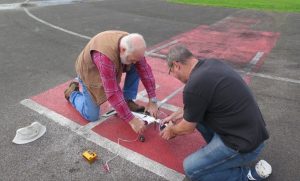 Nostalgic speed encompasses both Vintage and Weatherman Speed and each have a variety of classes catering for engine sizes from 0.8 to 10.0 cc.
Nostalgic speed encompasses both Vintage and Weatherman Speed and each have a variety of classes catering for engine sizes from 0.8 to 10.0 cc.
The Vintage Speed rules dictate that both engine and model design predate December 1958 providing a challenge in sourcing and operating such old engines and designs.
Weatherman speed is based on a model design by Cyril Shaw that dates back to 1947 which used a Mills 1.3 sideport diesel engine. The choice of engine in most classes is unlimited but by specifying two-line control, open exhaust and suction fuel feed it provides a relatively simple entry level speed competition.
 Precision Aerobatics
Precision Aerobatics
Precision aerobatics (Class F2B) consists of flying a fixed sequence of manoeuvres which are judged by a panel of judges for accuracy and precision. Factors such as height of the manoeuvre bottoms, shapes, corner radius, and other factors are considered. The judges at large competitions are typically trained for several days on how to assess the manoeuvres and apply a score. Judging well is generally considered at least as difficult as flying in competition. Stunt models tend to be among the larger Control Line models, wings usually spanning from around 45–60 inches (1.1–1.5m). Top competition models have been traditionally powered by a two-stroke engine in the 0.35 cubic inches (5.7cm3) to 0.60 cubic inches (9.8cm3) range, with four-stroke model engines and electric power also becoming popular. The aeroplanes, while possessing high thrust-to-weight ratios by full-scale standards (usually at least 1:1), are intended to fly quite slowly to enhance pilot control, typically around 55–60mph (89–97km/h), with a single lap of the circle taking around 5.5 seconds.
 Engines are commonly set to increase their power output when under load. More recently, tuned exhausts have been used to provide regulation of the speed in flight. Combined with propellers of relatively low pitch, this has permitted much more control over the engine’s speed and power response to manoeuvring. Electric motor installations contain feedback control systems that govern the RPM of the motor to a constant value regardless of load. Most competitive aircraft are fitted with flaps on the wings, which work in conjunction with the elevator to increase the pitch manoeuvrability. When up-elevator is applied, the flaps on the wings go down, and vice versa. This results in the wing, which is otherwise of a symmetrical section, to be cambered in the direction needed to enhance manoeuvring. Aircraft without flaps can be flown successfully and are typically simpler, but flapped models typically fly more smoothly and can be heavier. Of course, piloting at the highest levels can be remarkably difficult and time-consuming. Competition at the highest levels (National or World Championships) can take many years or decades of practice to master the intricacies of designing, building, finishing, adjusting, and controlling the power of the aeroplanes, in addition to the high piloting skills.
Engines are commonly set to increase their power output when under load. More recently, tuned exhausts have been used to provide regulation of the speed in flight. Combined with propellers of relatively low pitch, this has permitted much more control over the engine’s speed and power response to manoeuvring. Electric motor installations contain feedback control systems that govern the RPM of the motor to a constant value regardless of load. Most competitive aircraft are fitted with flaps on the wings, which work in conjunction with the elevator to increase the pitch manoeuvrability. When up-elevator is applied, the flaps on the wings go down, and vice versa. This results in the wing, which is otherwise of a symmetrical section, to be cambered in the direction needed to enhance manoeuvring. Aircraft without flaps can be flown successfully and are typically simpler, but flapped models typically fly more smoothly and can be heavier. Of course, piloting at the highest levels can be remarkably difficult and time-consuming. Competition at the highest levels (National or World Championships) can take many years or decades of practice to master the intricacies of designing, building, finishing, adjusting, and controlling the power of the aeroplanes, in addition to the high piloting skills.
 Racing
Racing
Racing is an event for two-person teams—the pilot and the pit crew. There are various racing classes of various levels of difficulty: F2C (the class flown internationally and at World Championships), Goodyear (semi-scale models of ‘Goodyear era’ full-size racers), Vintage classes and so on. However, the basic idea of all the events is that a number of models (up to three) fly together, aiming to complete a given number of laps in the shortest time. The model is also required to make multiple pit stops during the race, where it is refuelled, the engine restarted, and the model re-launched. This is the job of the pit crew. There are rules describing how the pilots must walk around each other (harder than one might think, as each model is on the end of a pair of control lines and travelling as fast as 130mph). Pit stops require that the model be refuelled and restarted.
The best FAI Team Race pit stops take around 7 seconds for the pilot to cut the motor and land, allowing the pit-man to catch the model which only moments ago was flying at 130mph (220km/h), fill the tank with 7cc fuel from a pressurised tank, adjust the engine mixture and compression if needed, restart, and re-launch the model. Some classes require that the model is refuelled using only a squeeze bottle thus making the system itself simpler.
 Combat
Combat
Combat is an event where to two pilots “dogfight” for cuts on their opponent’s streamer. Models are fast and highly manoeuvrable flying-wings, which chase each other around the sky at speeds in excess of 100mph (160 km/h). Due to the nature of the competition, the carnage rate is high, and pilots commonly bring 10 or more models to a competition. Combat is a highly tactical event, requiring great teamwork between a pilot and his two mechanics.
F2D combat – the international class for combat. Russia and Ukraine are currently the main producers of world-class equipment for this sport, including engines. Their combination of the latest engineering and design, with exotic metallurgy and experience, results in combat engines which reliably turn 32,000 rpm, and can be restarted easily in the event of a crash. Requiring lightning-fast reflexes, combat has frequently been used as a training-ground and/or hobby for many commercial and military pilots.
Vintage combat –The most popular class of combat currently in the UK is Vintage. These models are of an older, more traditional design using diesel engines. Pilots are only permitted one model per bout.
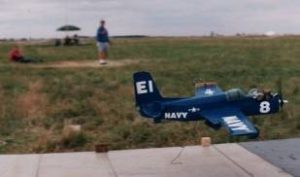 Carrier Deck
Carrier Deck
Navy carrier is an event where semi-scale models of real naval aircraft are flown. The event replicates the requirements of full-scale carrier aircraft, which need high speed for combat performance, low speeds and toughness for safe carrier landings. Take-off and landing are from a simulated aircraft carrier deck, with arrestor wires. The aim of the flight is to complete a number of fast laps, flown as quickly as possible, followed by a number of slow laps, flown as slowly as possible. This is followed by the carrier deck landing, attempting to snag the arrestor wire. The score depends on the difference of the high and low speed, and the arrested landing. Carrier models usually have a third control line, worked by a finger trigger in the handle. This line allows the throttle setting of the engine to be controlled and the arrestor hook to be dropped. Often, a carrier model will have flaps. A large amount of flap is usually applied during the slow laps, and a large amount of line sweep is added to yaw the model out of the circle to maintain line tension at the very low ground speeds. Low speeds are frequently no faster than a fast walk.
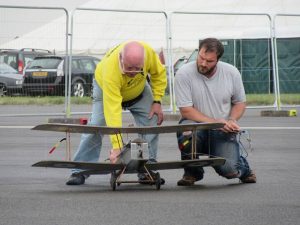 Scale
Scale
Scale is an event where an accurate scale model of a real aircraft is flown. Scoring is based on static judging of how closely the aircraft resembles the full-size prototype and on the flight performance. Extra points are often awarded for “working” features of the model, such as a retractable landing gear, droppable bombs, and other prototypical functions or operations. The number of features used to be limited by the number of lines that could be practically used to mechanically control them. Some complex scale models use a fly-by-wire approach to allow a multitude of extra working features. A radio-control transmitter’s encoder unit can be adapted, with no RF signal board present, to send its control signals along insulated control lines, instead of broadcasting them using radio frequencies.
